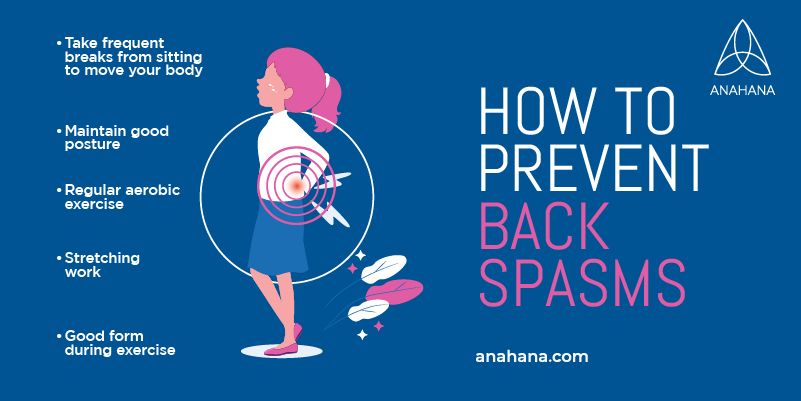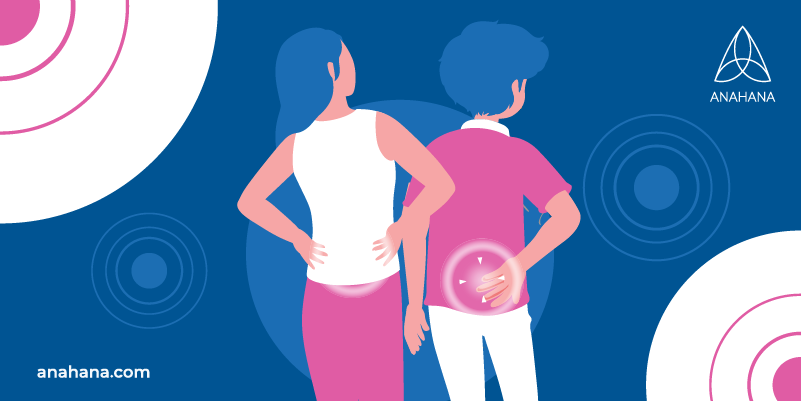5
What Are Back Spasms
Last Updated: November 4, 2024

Table of Contents
Back spasms and back pain are quite common and one of the top reasons why people may seek medical help. Various factors could cause a back spasm, including muscle injuries or strains, poor posture, age, or other underlying conditions. Luckily, many preventative methods help prevent back spasms – read below to find out.
Key Takeaways
- Definition: Back spasms are involuntary contractions, tightening, or seizing of the back muscles, often involving back and abdominal muscles.
- Symptoms: Include sudden tightness, pulsing, deep or sharp pains, and occasionally tingling, numbness, muscle weakness, or changes in bowel or bladder control.
- Causes: Result from muscle injuries, strains, poor posture, heavy lifting, and underlying conditions like spinal stenosis or disk herniations.
- Risk Factors: Include weak back muscle spasm, stomach muscles, obesity, older age, and prolonged sitting.
- Treatments: Range from rest, heat, ice, physical therapy, medications, muscle relaxants, and steroid injections for severe cases. Doctors often suggest physical therapy.
What Are Back Spasms
Back spasms are involuntary contractions, tightening, or seizing of the back muscles. One of the most common symptoms of a back spasm is a sudden feeling of tightness in the back. Other symptoms of a back spasm include pulsing and deep or sharp pains in the back. Rarely, a back spasm can cause tingling, numbness, weakness in the legs, and changes in bowel control. In those cases, a person should seek medical treatment immediately.
These muscle spasms can be severe enough to prevent normal movement such as walking, or they may be a more mild tightening of the back muscles. Pain from back spasms may be felt in the back, lower back, down into the hips, or buttocks. Muscle spasm pain can last for a short time or can last for more extended periods, up to a few weeks.
Causes Of Back Spasms
There are many possible causes of back spasms. Back spasms may occur due to an issue involving the muscles, ligaments, or joints in the back. Back spasms may be the result of injury or strain of the muscles of the back. These back muscle strains or injuries may be more common in those who have weak abdominal muscles and abdominal support.
Some other risk factors that may lead to back spasms include heavy lifting, older age, poor sitting posture, excessive sitting, and obesity. In addition, back spasms could also be related to poor mental health and stress. Occasionally, back spasms and back pain may have an underlying cause, such as an underlying spine problem. For example, back spasms may result from spondylolisthesis, when a vertebra, one of the spine bones, slips forward, affecting the spinal cord.
Other underlying spine conditions could cause back pain and spasms, including spinal stenosis or disk herniations. A doctor may use diagnostic tests such as an x-ray or MRI to get an accurate diagnosis of any underlying conditions.
Prevention Of Back Spasms
 Many preventative measures could help reduce the chance of experiencing back spasms. Physical activity levels, workplace environments, and daily activities may all be influential factors for someone experiencing re-occurring back spasms or back pain. Incorporating regular exercise into your daily routine is one strategy to prevent back spasms. An exercise routine focused on strengthening the abdominous muscles and back could help provide more support for the back.
Many preventative measures could help reduce the chance of experiencing back spasms. Physical activity levels, workplace environments, and daily activities may all be influential factors for someone experiencing re-occurring back spasms or back pain. Incorporating regular exercise into your daily routine is one strategy to prevent back spasms. An exercise routine focused on strengthening the abdominous muscles and back could help provide more support for the back.
Regular aerobic exercise is beneficial in increasing blood flow and preventing back spasms and low back pain. It is essential always to maintain good form during exercise to help prevent muscle strain or injury to the back. Regular stretching can also help to prevent back spasms.
It is also essential to be aware of maintaining good posture both while sitting and standing. Taking frequent breaks from sitting to move your body could also help prevent back spasms. These breaks could involve light stretching or even short walks. Education on protecting your back when lifting or performing repetitive movements is also important in preventing back spasms and pain.
Treatments For Back Spasms
Treatments of back spasms may vary depending on the severity and cause of the back spasm, and one should always consult a healthcare provider for severe back spasms or back spasms that do not improve within a week of rest.
It is essential to rest and avoid heavy lifting when experiencing back spasms and back pain to prevent further strain or injury to the back muscles and to help heal any existing injuries. Some self-care and at-home treatments that help to relieve back spasms include applying gentle heat, such as a heating pad. Gentle heat can help to relax the muscles and increase blood flow to those muscles and soft tissues to assist with healing.
Ice or a cold pack applied to the affected area may also help with back spasms and reduce back muscles' inflammation. A gentle back massage may also help treat back spasms and low back pain. A massage could be performed gently at home or by a registered massage therapist. Some gentle stretches, such as the child’s pose, reduce or relieve muscle spasms.
Physical therapy and rehabilitation treatment may be sought from people who experience long-term or chronic back spasms. Another long-term treatment for back spasms is yoga, which focuses on gentle stretching and strengthening the back and core muscles. Chiropractic care and spinal manipulation are other long-term treatments to decrease chronic back pain and spasms. Other treatments include acupuncture, tai chi, mindfulness, and stress reduction.
A healthcare provider may suggest or prescribe some medical management of back spasms, mainly when they cause intense pain. These include anti-inflammatory medications, muscle relaxant medications, and nonsteroidal anti-inflammatory drugs. Some healthcare providers may also recommend injections of anti-inflammatory medications such as cortisone. All medication benefits and risks should be discussed with a healthcare provider.
Final Thoughts
 Back spasms are very common and range from mild discomfort to severe pain and reduced mobility. The causes and treatments for these painful spasms vary and may depend on the underlying cause and severity of the muscle spasms. Causes could be poor posture, weak core muscles, a back injury, or an underlying condition.
Back spasms are very common and range from mild discomfort to severe pain and reduced mobility. The causes and treatments for these painful spasms vary and may depend on the underlying cause and severity of the muscle spasms. Causes could be poor posture, weak core muscles, a back injury, or an underlying condition.
Luckily, there are many strategies to implement daily that help to reduce the likelihood of experiencing these painful muscle spasms. Regular exercise, proper posture, stretching, and even relaxation techniques that can help protect the back may prevent these spasms. Some at-home remedies, such as heat for blood flow, ice to reduce inflammation, and gentle stretching to relax the muscles, may relieve mild spasms and pain. Other therapies, including physical therapy, massage, chiropractic care, and acupuncture, also can provide healing and relief. A doctor may have additional recommendations based on the cause and severity of the pain. Maintenance of physical activity and a healthy lifestyle can go a long way in preventing and treating back spasms and back pain.
Back Spasms FAQ
How long do back spasms last?
-
Back spasms may be relieved quickly with at-home remedies, such as heat, stretching, and muscle relaxation.
-
Back spasms can also last longer, up to weeks, and may require more extensive treatment depending on the cause of the spasm and the severity.
Are back spasms a severe condition?
-
Back spasms may be caused by mild strains or muscle injuries or could indicate a more severe condition.
-
A medical professional can provide an assessment to provide an accurate diagnosis of a more severe condition that may be the cause of a back spasm or lower back pain.
Is there a particular sleeping position to help with back spasms?
-
Sleeping positions that relieve pressure off your back, such as on your back with a pillow under your knees, could help reduce spasms and pain at night.
-
Having a good quality mattress with the right firmness can also help to reduce back pain at night.
References
https://www.healthline.com/health/back-pain/lower-back-spasms#causes
https://my.clevelandclinic.org/health/diseases/22881-back-spasms
https://www.verywellhealth.com/causes-of-back-spasms-5095832
https://jamanetwork.com/journals/jama/fullarticle/2782184
https://www.medicalnewstoday.com/articles/322369#long-term-treatment
https://academic.oup.com/aje/article/187/5/1093/455790
https://www.reidhealth.org/blog/5-tips-to-lessen-back-pain-at-night
Disclaimer
The contents of this article are provided for informational purposes only and are not intended to substitute for professional medical advice, diagnosis, or treatment. It is always recommended to consult with a qualified healthcare provider before making any health-related changes or if you have any questions or concerns about your health. Anahana is not liable for any errors, omissions, or consequences that may occur from using the information provided.

Dr. Darlene Buan-Basit is a highly experienced licensed Chiropractor and Pilates instructor with expertise in many techniques, including Medical Acupuncture, Traditional Chinese Medicine, and Advanced Massage Techniques.